Vultures play a critical role in the environment as scavengers of carrion. They provide an important ecological service in consuming carrion which reduces the risk of diseases from spreading in the environment. Turkey and black vultures, as with all other wildlife, will take advantage of resources available to them, unfortunately this can cause issues when it involves human dwellings and in some cases livestock operations.
Black vultures, in particular, are increasing in population and their aggressive nature can cause problems for livestock producers in Missouri. Unlike their less-aggressive cousin, the turkey vulture, black vultures are known to gang up and prey on calves, piglets, lambs, and newborn goats. They sometimes attack cows that are ill or giving birth. Black vultures can also cause property damage and problems by damaging rubber seals and windshield wipers on parked vehicles, canvas awnings and seating on boats, and rubber or vinyl materials on rooftops.
Legally, black vultures are protected under the federal Migratory Bird Treaty Act of 1918. Their migratory range extends for thousands of miles from North America to the lower portions of South America, crossing national boundaries. It is illegal to harm or take (kill) black vultures without a permit.
Life history and habitat requirements
Black vultures (Coragyps atratus) are a native species to Missouri. During the past number of years their population numbers have increased to the point where they are common across much of the state. Black vultures are present throughout the year in the state. However, they are a migratory species ranging from South America to Canada which is why numbers tend to increase in the fall and winter as northern birds move south. They are a medium sized vulture at 23 to 27 inches in height, with a wing spread upwards of 5 feet, and weigh around 3.5 to 5 pounds. They are slightly smaller than the turkey vulture, the other native vulture in Missouri, and can be distinguished from them in several ways.
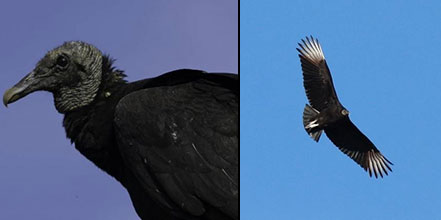
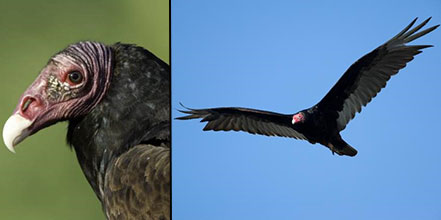
- Adult turkey vultures have a bright red head whereas the black vulture has a gray black head (Figures 1 and 2). However, juvenile turkey vultures also have a gray head so younger birds can be confused with black vultures.
- In flight black vultures hold their wings in a more horizontal position and tend to flap more compared to turkey vultures that have more of a V-shaped profile and soar for longer durations without flapping (Figures 1 and 2).
Feeding behavior
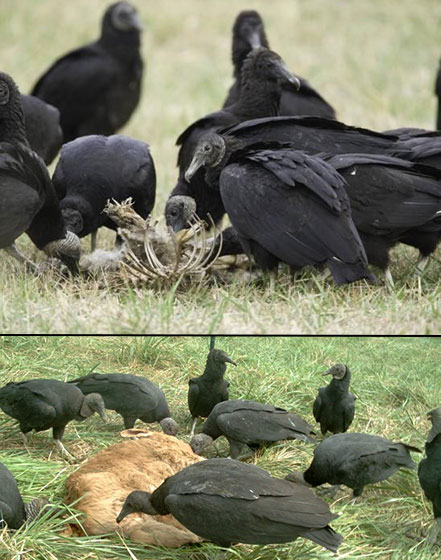
- Vultures play a pivotal role in the ecosystem by feeding upon and thus cleaning up carrion and dead animal carcasses.
- Black vultures are generally carrion feeders (dead animals); however they will kill small to medium sized animals on occasion (Figure 3).
- They use visual cues to locate food sources.
- Vultures in general will feed on the softest tissues first. Eyes, tongues, and hind quarters are typically missing from carrion that they have been feeding on.
Roosting behavior
Black vultures commonly roost in groups often comprised of both black vultures and turkey vultures, especially during the winter months (Figure 4). Group sizes can vary but they can get rather large, roost sizes upwards of 100 individuals or more are not uncommon. These roosts play an important role for the species, acting as a communication center.
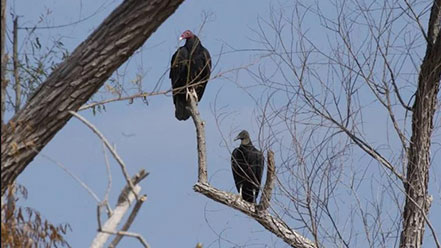
Evidence of black vulture depredation
The presence of black vultures on farms can be an issue for livestock producers. Black vultures are known to take livestock when given the opportunity.
Black vultures leave characteristic evidence of their depredation. They can inflict damage to livestock by plucking their eyes, eating tongues of newborn animals, kill and feed on domestic fowl, and leave scars on those animals which survive.
Although black vultures prey on livestock, the actual number of attacks is difficult to determine. Many incidents most likely go unreported. Sometimes determining whether black vultures are the culprit can be difficult to determine.
When a vulture kills an animal, there is generally large amounts of blood at the scene. Often vultures are blamed for killing animals that are already dead. If there is no blood at the scene then it is likely that the animal was already deceased prior to the arrival of vultures.
Black vultures use visual cues for finding food sources. They drive away predators or scavengers by sheer numbers and their aggressive behavior.
Black vulture problems
Residential issues: Black vultures may peck and damage rubber seals and windshield wipers on parked vehicles, canvas awnings and seating on boats, and rubber or vinyl materials on rooftops. Property damage and droppings are an issue for some homeowners, while others consider them “peace eagles” and a tourist attraction.
Depredation to livestock: Black vultures leave characteristic evidence of their depredation. Black vultures can inflict gruesome damage to livestock. They pluck eyes and eat tongues of newborns, down, or sick livestock; disembowel young livestock; kill and feed on domestic fowl; and leave scars on those animals which survive.
Although black vultures prey on livestock, the actual number of attacks is difficult to determine. It is believed many such incidents go unreported. Sometimes determining whether black vultures are the culprit can be difficult to prove. Stillborns and incapacitated animals are easy prey for a number of predators and scavengers.
Black vultures use visual cues for finding food sources. They drive away predators or scavengers by sheer numbers and an aggressive nature, obscuring what actually caused the animal's demise.
Damage control techniques
Non-lethal harassment options
Vultures are a federally protected by the Migratory Bird Treaty Act of 1918. This means that the birds, their nests, and eggs cannot be killed or destroyed without a Migratory Bird Depredation Permit (see permit information below).
- It is perfectly legal to harass vultures and use effigies to scare them away. However, if a real bird is used, then a permit is required.
- Harassment is conducted to make the vultures feel unsafe or uncomfortable in an area, which may cause them to leave and not return.
- Techniques to disturb vultures include loud noises (i.e., blow horns), spraying with a garden hose, or using pyrotechnics may be required. Other effective tools include the use of non-lethal shooting and propane cannons, especially in large pasture settings.
Frightening vultures using lasers or pyrotechnics
Frightening black vultures using various devices may work in some situations. Protecting larger livestock operations is more difficult where cattle range over large acreages. Around smaller livestock operations, problems with black vultures may be alleviated with constant vigilance and persistent harassment. Loud noises are often used for disturbing and moving black vultures from roosts. These tactics should be employed before black vultures become established at their roosting site.
Black vultures that have been allowed to occupy a roost for an extended time are more difficult to drive away. For established roosts, USDA APHIS-Wildlife Services recommends using laser pointers or pyrotechnics. Lasers can be a hazard for low flying airplanes, so the proper authorities should be consulted. Types of pyrotechnics include a starter pistol (like those used in races), shell crackers fired from a 12-gauge shotgun, or propane cannons which periodically emit a loud boom. In urban and some rural locations, nearby residents need to be contacted before using these pyrotechnics.
A federal permit is not required for using lasers or pyrotechnics to scare black vultures and other migratory birds in Missouri. However, federal laws may disallow using lasers near airports and flight paths.
Using vulture replicas as a deterrent
The USDA National Wildlife Research Center recommends frightening black vultures from roosts using effigies (replicas) of dead black vultures. Vulture effigies should be visible and hung upside-down by the legs with wings splayed. The Center found that effigies resembling a full-grown vulture -- 25 to 26 inches in length and feathered -- were effective. In Missouri a permit for shooting and displaying nuisance birds to frighten other black vultures can be obtained free of charge by contacting the Missouri Farm Bureau. Contact 573-893-1416 for assistance for obtaining a permit. However, the continued effectiveness of effigies over time may cause the birds to become habituated to the repeated use of these techniques.
Disturbing roosts

- Roosts can be disturbed if they are not nesting or have young. It may be necessary to inspect a roost area for signs of an active nest (eggs or chicks) in late spring and early summer prior to starting a harassment program.
- Roost disturbances should occur around ½ hour prior to sunset till ½ hour after sunset and should be completed over multiple consecutive days to increase the probability of successfully making the birds permanently leave the roost. With larger roosts harassment may need to be continued for upwards of 7-14 days. Even if you are successful in causing the birds to leave the area they may return several weeks or months later and harassment will have to occur again.
- Since harassment efforts do require loud noises, there are potential legal implications if damage issues are occurring in an urban or community setting. Prior to beginning harassment, especially those involving any form of pyrotechnics, local authorities should be contacted to ensure compliance with local ordinances.
- You can also use an effigy to disrupt a vulture roost by hanging it as close to the roost as possible (Figure 5).
- Vultures often use dead trees as perches around pastures and areas being used by livestock. Removing dead roost trees can encourage vultures to move to other areas.
Livestock management practices
- Livestock producers can discourage black vultures by penning birthing cows, goats, and sheep near human activity. This enables closer observation of an expectant animal and a quicker response to problem situations, thereby improving a young animal's survivability. Some producers have success with livestock guard dogs which can frighten, chase, or dissuade black vultures and other potential predators.
- Implement cultural practices such as moving livestock to a pasture that allows you to keep a close eye on them during birthing. In addition, if the livestock birthing time frame can be condensed as much as possible while keeping the herd close to human activity, depredation losses can be greatly reduced.
- The most efficient manner to decrease the likelihood of black vulture affecting your herd is to place a vulture effigy around calving areas.
- One of the best methods is to hang the effigy by the feet using a rope and suspend it in the air making it visible from a distance.
- Hang it at a high point that is visible from all sides directly adjacent to, or in, the calving pasture, to maximize effectiveness.
- After vultures are no longer a threat, or you are no longer expecting newborn livestock, you may want to place any non-plastic (i.e., birds taken by a damage permit) effigies in a plastic bag and freeze it to be used again in the future if needed.
Lethal control options: How to apply and get a damage permit
USDA APHIS Wildlife Services – Missouri: The USDA Animal and Plant Health Inspection Service - Wildlife Services is charged with responding to conflicts with migratory species including black vultures. It is very important to contact USDA APHIS Wildlife Services, particularly those requesting a site visit or if technical advice is needed. Contact the State Office in Columbia Missouri at 573-449-3033 x10 to discuss the problem and/or schedule a site visit for a customized damage management plan.
Missouri Farm Bureau: Producers experiencing livestock depredations from black vultures can obtain a permit free of charge for taking up to five birds annually from the Missouri Farm Bureau. The landowner must contact Missouri Farm Bureau to discuss additional bird authorization. Information on how someone can obtain a permit can be found at Missouri Farm Bureau Black Vulture Depredation Sub-Permit Program Application and Approval Process (PDF) or by calling 573-893-1416.
A document describing guidelines for using effigies to disperse nuisance vulture roosts (PDF) is available for download. All permittees must report their takes to the Missouri Farm Bureau. The permit is valid from January to December of the calendar year. No other bird species are authorized to be taken under this program.
Disposing of dead livestock
When a depredation event occurs or when livestock succumb to any other form of mortality, disposing of dead livestock correctly can have substantial benefits for deterring both future vulture and other wildlife-related issues. Decreasing the amount of time the carcass can be found by vultures and other predators will lower the risks of them frequenting the area. The laws and regulations regarding disposal and composting of dead animals specific to Missouri can be found in MU Extension publication WQ216, Routine Animal Mortality Management Options in Missouri.
Livestock Indemnity Program
When proof of black vulture depredation is obtainable, producers can apply for reimbursement through the Livestock Indemnity Program under the USDA Farm Service Agency (FSA).
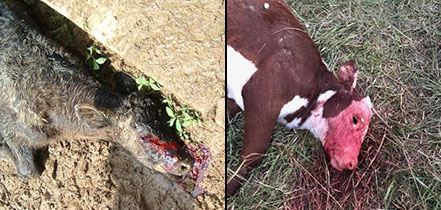
- There must be strong evidence of vulture depredation including authentication by a date-stamped photo or video. Also required is documentation of livestock ownership through purchase or other means. A local FSA committee determines whether there is enough evidence to warrant reimbursement, which can be up to 75% of the average fair market value of livestock lost. For additional information, contact Missouri FSA. If the depredation is actively occurring, take photos and attempt to scare the birds away.
- You should take pictures of the suspected vulture depredated livestock as soon as possible after you find it.
- Make sure pictures are of the entire animal but focus on the face and rear parts of the animal as seen in Figure 6. The correct documentation is important as it may be difficult to determine whether the black vultures killed the livestock they are feeding on or are feeding on already dead animals. Remove the animal from the area to ensure other vultures or wildlife species do not continue to feed on the carcass.
- It is extremely important that pictures are taken and the carcass removed as soon as possible to keep from attracting more animals to the area.
Resources, websites and publications
- Managing Black Vulture Damage in Missouri brochure (PDF), USDA
- Missouri Vultures, Missouri Department of Conservation
- Wildlife Damage Management Technical Series: Vultures (PDF), USDA APHIS Wildlife Services
If you are having problems with vulture damage, USDA APHIS Wildlife Damage Assistance can help by providing information and advice to reduce damage. Research is also conducted to develop new methods for resolving these conflicts.